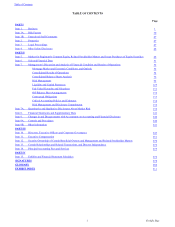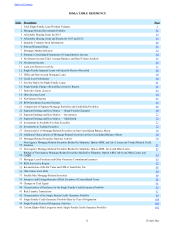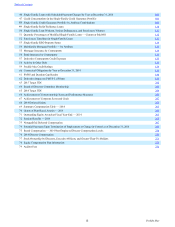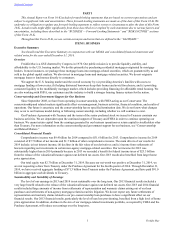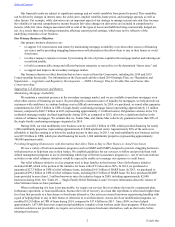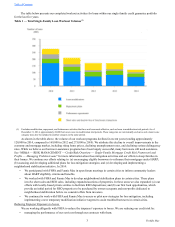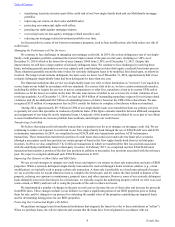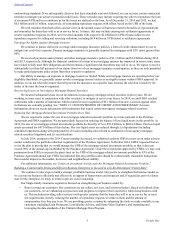Freddie Mac 2014 Annual Report Download - page 10
Download and view the complete annual report
Please find page 10 of the 2014 Freddie Mac annual report below. You can navigate through the pages in the report by either clicking on the pages listed below, or by using the keyword search tool below to find specific information within the annual report.
5Freddie Mac
underwriting standards. If we subsequently discover that these standards were not followed, we can exercise certain contractual
remedies to mitigate our actual or potential credit losses. These remedies may include requiring the seller to repurchase the loan
at its current UPB and/or to reimburse us for the losses we realized on the loan. As of December 31, 2014 and 2013, we had
$0.3 billion and $1.6 billion, respectively, of outstanding repurchase requests with sellers, based on the UPB of the loans.
We seek remedies from both sellers and servicers in the normal course of business related to breaches of representations
and warranties for loans they sold to us or service for us. At times, this may include entering into settlement agreements to
resolve repurchase requests. In 2014, we recovered amounts with respect to $2.0 billion in UPB of loans subject to our
repurchase requests for selling and servicing violations, including $0.4 billion in UPB related to settlement agreements.
Pursuing Our Rights Against Mortgage Insurers
We continue to pursue claims for coverage under mortgage insurance policies, a form of credit enhancement we use to
mitigate our credit loss exposure. Primary mortgage insurance is generally required for mortgages with LTV ratios greater than
80%.
We received payments under primary and other mortgage insurance policies of $1.1 billion and $2.0 billion during 2014
and 2013, respectively. Although the financial condition of certain of our mortgage insurers has improved in recent years, some
have failed to fully meet their obligations and there remains a significant risk that others may fail to do so. We expect to receive
substantially less than full payment of our claims from two of our mortgage insurance counterparties, as they are only permitted
to make partial payments under orders from their respective regulators.
Our ability to manage our exposure to mortgage insurers is limited. While our mortgage insurers are operating below our
eligibility thresholds, we generally cannot revoke a mortgage insurer's status as an eligible insurer without FHFA approval. In
addition, we do not select the insurer that will provide the insurance on a specific loan. Instead, the selection is made by the
lender at the time the loan is originated.
Recovering Losses on Non-Agency Mortgage-Related Securities
We incurred substantial losses on our investments in non-agency mortgage-related securities in prior years. We are
working, in some cases in conjunction with other investors, to mitigate or recover our losses. In 2014, we and FHFA reached
settlements with a number of institutions which resulted in our recognition of $6.1 billion of income. Lawsuits against other
institutions are currently pending. See “NOTE 15: CONCENTRATION OF CREDIT AND OTHER RISKS” for more
information about our recent agreements with institutions that issued certain non-agency mortgage-related securities.
Reducing Our Mortgage-Related Investments Portfolio Over Time
We are required to reduce the size of our mortgage-related investments portfolio over time pursuant to the Purchase
Agreement and FHFA regulation. We are particularly focused on reducing the balance of less liquid assets in this portfolio. In
2014, the size of our mortgage-related investments portfolio declined by 11% or $52.6 billion, to $408.4 billion. Our less liquid
assets accounted for $47.0 billion of this decline. Our less liquid assets are reduced through: (a) liquidations (including
scheduled repayments along with prepayments); (b) sales (including sales related to settlements of non-agency mortgage-
related securities litigation); and (c) securitizations.
In July 2014, pursuant to the 2014 Conservatorship Scorecard, we submitted a plan to FHFA to meet (even under adverse
market conditions) the portfolio reduction requirements of the Purchase Agreement. In October 2014, FHFA requested that we
revise the plan to provide that we would manage the UPB of the mortgage-related investments portfolio so that it does not
exceed 90% of the annual cap established by the Purchase Agreement. Under the revised plan approved by FHFA, we may seek
permission from FHFA to increase the plan's limit on the UPB of the mortgage-related investments portfolio to 95% of the
Purchase Agreement annual cap. FHFA has indicated that any portfolio sales should be commercially reasonable transactions
that consider impacts to the market, borrowers and neighborhood stability.
For additional information, see “Limits on Investment Activity and Our Mortgage-Related Investments Portfolio.”
Building a Commercially Strong and Efficient Business Enterprise to Succeed in a To-Be-Determined “Future State”
We continue to take steps to build a stronger, profitable business model. Our goal is to strengthen the business model so
we can run our business efficiently and effectively in support of homeowners and taxpayers and, if required as part of a future
state for the enterprise, be ready to return to private sector ownership.
Our Single-family Guarantee segment is focused on strengthening our business model by:
• Better serving our customers: Our customers are our sellers, servicers, and investors/dealers. Based on feedback from
our customers, we are enhancing our processes and programs to improve their experience when doing business with
us. This includes providing seller/servicers with greater certainty that the loans they sell to us or service for us meet
our requirements, thereby reducing the number of repurchase requests we make to them and the amount of
compensatory fees they pay to us. We are providing greater certainty by enhancing the tools we make available to our
customers (including Loan Prospector, Loan Quality Advisor, and Home Value Explorer), and expanding and
leveraging the data standards of the Uniform Mortgage Data Program.
Table of Contents


